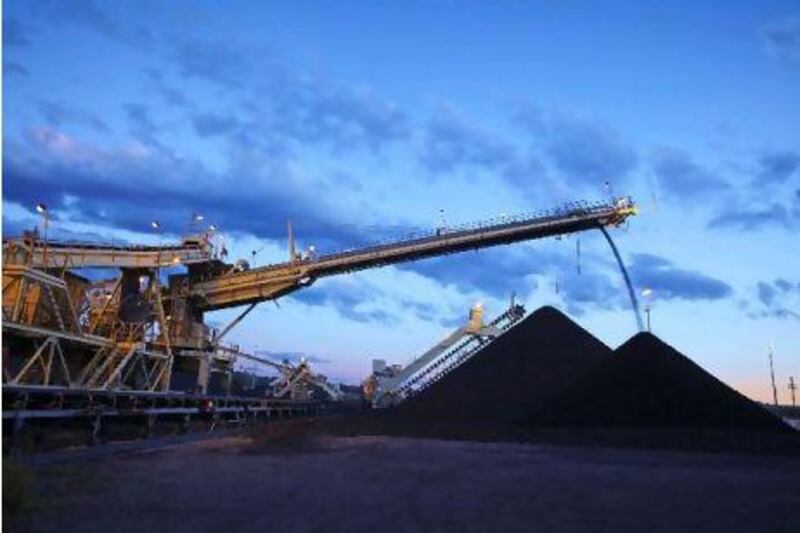A giant hole more than 200 metres deep opens before me. At the bottom, four immense machines are delving into the earth, loading coal on to an endless conveyor.
Editor's Pick: The big business stories making headlines today
UK seeks role rebuilding Libya The UAE teams up with the UK and a number of leading businessmen to assist the rebuilding of economies hit by the Arab Spring - watch video. Read article
Capital flight from Egypt and Libya hit $8 billion during Arab Spring Capital flight from Libya, Egypt and Tunisia topped $8.6 billion in the first quarter of this year, according to a new report from the Bank for International Settlements - watch video. Read article
Nakheel's $16bn bond faces test Nakheel's new Islamic bond is falling in price, sending yields skyward. Read article
Looking as though they belong in Darth Vader's armies, they are too big to fit in the world's largest cricket stadium, the nearby Melbourne Cricket Ground.
For this is Australia, one of the countries where coal, king of 19th century industry, is making a comeback.
Coal has an old-fashioned image, associated with Victorian chimney sweeps and London "pea-souper" fogs. The days of the Great Western steamship or Flying Scotsman steam train are long behind us. Coal is today primarily used to generate electricity, and in industries such as steel making. Its use in Europe and the US is declining.
But elsewhere, coal is booming. Since the millennium, global oil consumption has risen just 13 per cent, that of gas by 31 per cent, but coal use is up almost 50 per cent.
The driving force for this explosive growth is, of course, China. Despite all its efforts on developing green energy, and on scouring the world for oil and gas supplies, the bulk of the energy to feed its ravenous economy comes from inexpensive, secure, domestic coal. Five million people work in China's mines; there, as in Australia, South Africa, Poland and many US states, coal is a key part of employment and society.
As with other resources such as gas and iron ore, Australia is in on the act. In December 2008, the Australian coal magnate Clive Palmer paid A$140 million (Dh527.4m) for a coal field in the state of Queensland. Just two years later, naming the mine China First, he signed a deal valued at $60 billion to sell the coal to China Power.
The coal resources in the Latrobe Valley near Melbourne are much less well known than the world's largest gas field, Qatar's North Field, or the biggest oil field, Saudi Arabia's Ghawar, but they contain a similar amount of energy and will last for 500 years at current extraction rates.
Elsewhere globally there is at least a century's worth, with more to be found when demand warrants. And coal is cheap: less than half the price of gas in Europe or east Asia, and barely a sixth of the price of oil.
But coal is not only about China: it is on its way to the Middle East.
At cement plants in the Northern Emirates, you will notice mounds of coal, used instead of gas, which is locally in short supply. Ras Al Khaimah, Ajman and Oman have all mooted coal-fired power stations. In June, Saeed Mohammed Al Tayer, the chief executive of the Dubai Electricity and Water Authority (Dewa), announced the Emirate would double the size of its planned coal plant to a giant 3 gigawatts, equal to almost half Dewa's current capacity.
The great problem with coal is, of course, its environmental impact. Modern plants can remove the sulphur responsible for acid rain, and the fine particles that cause lung damage. China has this equipment, but it is mostly not used because of market pressures and weak regulatory enforcement, leading to choking, sooty, gritty cities. A brown cloud, swelled by coal smoke, is visible from space hovering over Asia during the winter. It is estimated more than two million people die in India alone each year from its effects.
Even worse for humanity, coal is the most carbon-intensive fuel. Burning just a small part of global coal resources will raise levels of carbon dioxide in the atmosphere to levels high enough to trigger dangerous changes in climate.
Yet it is just not feasible to abandon coal rapidly. Renewable sources such as wind and solar are growing fast, but coal still provides 20 times more energy, and is essential in efforts to bring affordable electricity to many of the 1.6 billion people around the world still without it.
The answer is in modern ways of using coal. New coal boilers running at ultra-high temperatures and pressures are dramatically more efficient than the 1950s vintages still common in the US and Australia. Coal can be turned into a gas, and used in clean power plants, or to make chemicals or synthetic oil, as in several new Chinese projects.
Most importantly, the carbon dioxide from coal combustion must be captured rather than released into the atmosphere. From there, the carbon dioxide can be disposed of safely underground, or turned into useful products or solid minerals.
The first generation of full-scale projects bears a price tag of several billion dollars and, with lukewarm government support, has been frustratingly slow to move forward. But with major schemes now advancing in the US, Canada and China, and proposed for the plant in Dubai, carbon capture for coal may be on the verge of realisation.
The vast quantities of coal slumbering beneath the Latrobe Valley farmlands are a climatic peril and an economic prize. With innovations and wise choices, these contradictions can be reconciled and the reign of King Coal can continue for many years to come.
* Robin Mills is an energy economist based in Dubai and author of The Myth of the Oil Crisis and Capturing Carbon.





